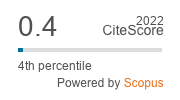Diversity of Hemipteran families at Agri-biodiversity park, Hyderabad, India
DOI:
https://doi.org/10.33307/entomon.v46i2.600Abstract
The diversity and abundance of Hemipteran families at Agri-biodiversity park of Professor Jayashankar Telangana State Agricultural University, Hyderabad, Telangana, India was studied from September 2019 to January 2020. A total of 12,575 individuals under 22 families of Hemiptera were recorded by using five different collection methods viz. pitfall trap, yellow pan trap, manual collection, light trap and yellow sticky trap. Family Cicadellidae was found to be the most abundant family (RA=32.70%), followed by Aleyrodidae (RA=12.47%) and Delphacidae (RA=12.30%), while Eurybrachidae (RA=0.10%), Flatidae (RA=0.10%) and Scutelleridae (RA=0.11%) were the least abundant families. Among the five different collection methods, light trap recorded the maximum number of individuals (6010) followed by yellow sticky trap (3815) whereas, manual collection method (313) recorded the least number of individuals. The Shannon-Weiner diversity Index, Margalef’s species richness index and Pielou’s evenness index for the Hemipteran fauna of the study area were 2.252, 2.225 and 0.728 respectively.


